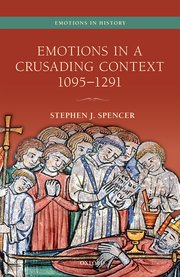 Emotions in a Crusading Context is the first book-length study of the emotional rhetoric of crusading. It investigates the ways in which a number of emotions and affective displays — primarily fear, anger, and weeping — were understood, represented, and utilized in twelfth- and thirteenth-century western narratives of the crusades, making use of a broad range of comparative material to gauge the distinctiveness of those texts: crusader letters, papal encyclicals, model sermons, chansons de geste, lyrics, and an array of theological and philosophical treatises. In addition to charting continuities and changes over time in the emotional landscape of crusading, this study identifies the underlying influences which shaped how medieval authors represented and used emotions; analyzes the passions crusade participants were expected to embrace and reject; and assesses whether the idea of crusading created a profoundly new set of attitudes towards emotions.
Emotions in a Crusading Context is the first book-length study of the emotional rhetoric of crusading. It investigates the ways in which a number of emotions and affective displays — primarily fear, anger, and weeping — were understood, represented, and utilized in twelfth- and thirteenth-century western narratives of the crusades, making use of a broad range of comparative material to gauge the distinctiveness of those texts: crusader letters, papal encyclicals, model sermons, chansons de geste, lyrics, and an array of theological and philosophical treatises. In addition to charting continuities and changes over time in the emotional landscape of crusading, this study identifies the underlying influences which shaped how medieval authors represented and used emotions; analyzes the passions crusade participants were expected to embrace and reject; and assesses whether the idea of crusading created a profoundly new set of attitudes towards emotions.
Emotions in a Crusading Context calls on scholars of the crusades to reject the traditional methodological approach of taking the emotional descriptions embedded within historical narratives as straightforward reflections of protagonists' lived feelings, and in so doing challenges the long historiographical tradition of reconstructing participants' beliefs and experiences from these texts. Within the history of emotions, Stephen J. Spencer demonstrates that, despite the ongoing drive to develop new methodologies for studying the emotional standards of the past, typified by experiments in 'neurohistory', the social constructionist (or cultural-historical) approach still has much to offer the historian of medieval emotions.

No comments:
Post a Comment